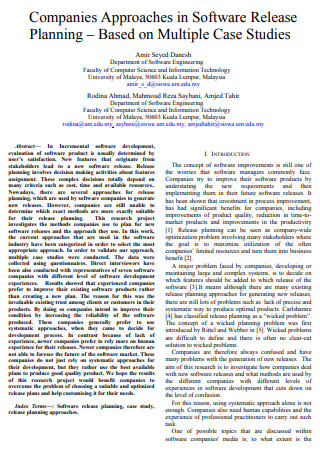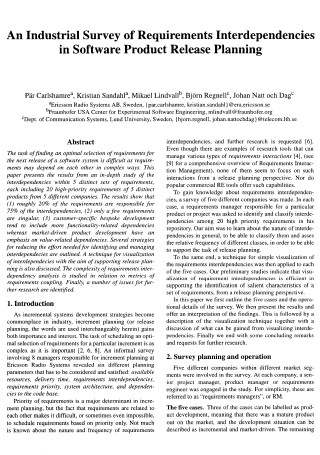26+ SAMPLE Software Release Plan
-

Software Release Plan
download now -

Survey on Software Release Plan
download now -

Software Release Planning Process
download now -

Analysis of Software Release Plan
download now -

Sample Software Release Plan
download now -

Software Release Research Plan
download now -

Software Release Planning Methodology
download now -

Software Project Release Plan
download now -

Software Release Planning in Industry
download now -

Software Engineering Release Plan
download now -

Software Product Release Plan
download now -

Practice on Software Release Planning
download now -

Quantitative Studies in Software Release Planning
download now -

Web Based Software Release Plan
download now -

Approaches in Software Release Plan
download now -

Software Enterprise Release Plan
download now -

Software Release Plan Model
download now -

Simple Software Release Plan
download now -

Software Product Release Planning
download now -

Software Multi-Release Planning
download now -

Software Bi-Objective Release Planning
download now -

Defect Prediction in Software Release Planning
download now -

Basic Software Release Planning
download now -

MaX Software Release Plan
download now -

Integrated Software Release Plan
download now -

Scheduling in Software Release Plan
download now -

Software Release Management Plan
download now
FREE Software Release Plan s to Download
26+ SAMPLE Software Release Plan
What is a Software Release Plan?
Elements of a Software Release Plan
Different Types of Software Releases
The Software Release Life Cycle
How to Plan a Software Release
FAQs
What does Release to Manufacturing (RTM) mean?
What is a software release?
Why is planning for a software release so important?
What is a Software Release Plan?
What does a software release plan mean? Well, it simply refers to a plan in which developers and other relevant people follow a specific schedule for software releases. One such method is an agile software release plan. In this plan, numerous updates are staggered and handled for optimization in many release strategies. Having a release strategy like this proves to be advantageous because it may make the process of releasing software more organized and efficient.
More importantly, having a software release plan also adds to a much more methodical philosophy of software development by assisting different companies in understanding how to work a lot better toward the final phases of development while minimizing interruption and confusion throughout a highly involved process.
Elements of a Software Release Plan
Here are the following details that are usually recorded when creating a software release plan:
Different Types of Software Releases
Software releases also come in different types. You may wonder what are those types, so here it is:
- Major Software Release – the first type of software release is a major software release. What does it mean? Simply put, a major software release will usually contain a variety of adjustments to current functionality as well as the addition of totally new capabilities to the software. The majority of them address the flaws and bugs that were present in the previous version of the product.
- Minor Software Release – the second type of software release to be discussed is a minor software release. What does it mean? Well, in these types of software releases, small enhancements and issues are typically addressed. In order to provide large-scale point updates, these improvements and issues are typically installed on top of major releases.
- Emergency Software Release – this is the third and final type to be discussed. But what is this? To answer, these types of updates repair flaws and problems in software programs that cause them to operate poorly. End-users are having difficulty using the software, and thus the issues must be resolved as soon as possible.
The Software Release Life Cycle
Have you ever wondered what stages does a particular kind of software undergoes before it is fully released to the public for general use? Well, here is the software release life cycle to explain all the stages:
How to Plan a Software Release
Whenever you are planning for a software release, keep in mind that it should be an activity with the full involvement of the software development team. With that being said, here are the steps to successfully plan a software release:
-
1. Define/Identify Your Release Goal
The first step in planning for a successful software release is to obviously determine what your release goal is. During this step, the entire team must be able to describe the general aim of the release as well as how the release is connected with the product’s bigger vision and strategy. Holding a meeting to come up with a list as to what has to be included in the rollout is one option. The correct approach to do so is to examine your to-be-released log and determine the features/bug fixes that fit your team’s definition of ready. It is also critical at this time to hear from the software developers about any technical issues or prospective obstacles that may cause the release process to fail.
-
2. Check for any Backlogs
This step is done after identifying the release goals of the plan. In this step, what you need to do is to go through the entire work backlog and rate your team’s work items, prioritizing them based on their relevance for the release goal. You should remember in this step that you’re seeking to find the most critical elements to support the objective in this phase, so be prepared to eventually leave out less vital features for future iterations of the software release.
-
3. Provide a Release Estimate
Once all the backlogs/critical tasks have been sorted, it is then time to provide an estimate of the product release. In order to aid with the planning phase, the backlog items, as many of them identified in the previous stage as feasible, should already have the latest corresponding narrative point estimations. It is also important to do a review on all the estimates with your team, adjust them as appropriate, and create corresponding fresh estimates for any backlog items that have not yet been estimated.
-
4. Determine and Create Release Sprints
How you determine the number of sprints is based on the results of the provided release estimate. Once you’ve successfully determined how many sprints you need, you can start creating them. But what is a release sprint? A release sprint is primarily focused on delivering new deliverables. There is no development at this time, however frequent tasks on your backlog during a release sprint comprise of performance testing, completion of user documentation, error repair, and other activities. If your process includes particular activities for putting software into production, a supplementary sprint might be formed to complete those responsibilities.
-
5. Prepare for Initial Launch
Preparation in this step usually includes setting a target completion or release date for the sprints or the software. Sometimes you have to launch features into the production process that aren’t yet ready for all consumers to consume. If this occurs, you can employ a technique known as dark launching. You’re essentially limiting access to program functionality when you use dark starting. You may enable and disable various features for specific groups, individual clients, or everyone. Using this method, your team may quickly release functions and test them in production.
-
6. Update the Release Plan and Prepare for Contingencies
Once everything is set in motion, all you have to do is continuously update the release plan. One thing you can do is to revisit the release plan on a frequent basis to monitor how the team is doing against the plan and to look for any changes that may affect what assets will be delivered or the date of delivery. If something changes, the strategy must be modified, and you may need to speak with business owners and many others. If something goes awry or should any contingencies arise, you should have a plan in place to reverse a release and return the back to its initial condition. This is known as a rollback plan.
FAQs
What does Release to Manufacturing (RTM) mean?
The term “Release to Manufacturing” basically refers to the version of the software that is initially made available to hardware makers for bundling. The RTM procedure is advantageous in that it assists developers in working out any flaws before to wide release through manufacturer refining of the program. This version of software may be digitally signed, allowing the end-user to validate the software’s integrity and validity. This term is also commonly used across general merchandise mass-production software contexts in which the software is sold as part of a package in a related computer hardware sale and where the software and related hardware are eventually to be available and sold on a mass/public basis at retail locations to indicate that the software has fulfilled a defined level of quality and is suitable for mass retail distribution.
What is a software release?
A software release is the official version of the software that is made available to end-users after some more enhancements and bug fixes. Several actions are included in the process, including analyzing the requirements for release, developing the necessary codes, building, deployment, and software testing. Depending on the updates and changes done in the program, the future software release might be either private or public.
Why is planning for a software release so important?
Planning a software release is very important since it enables you to set and clarify the corresponding objectives of the software release, define the scope of the release plan, create a rough estimate as to when a set goal or a set number of release sprints should be completed, oversee the software release implementation and completion, and identify any constraints or contingencies that may arise.
Software is one of the products in our digital world that are constantly changing. Every now and then, new updates are released that may contain fixes to critical bugs, or they may contain new features to improve the quality of life of the end-user that utilizes the product. With the help of a clear and concise software release plan behind the scenes, it always gives a guarantee that the subsequent software releases will have high reliability. In this article, you can find different examples of a software release plan that you can use as a personal reference in case you need to make one.
